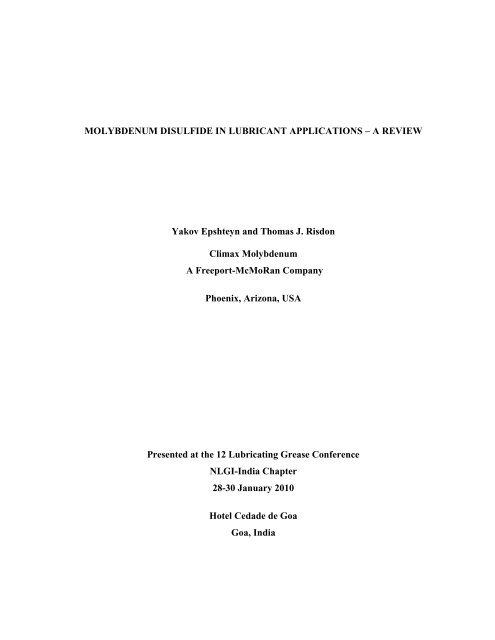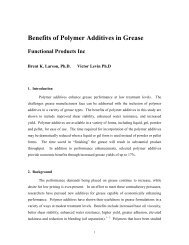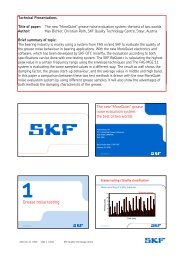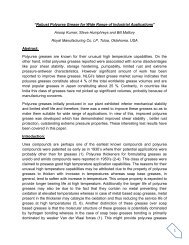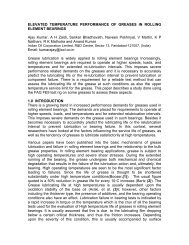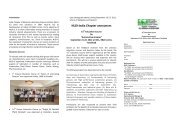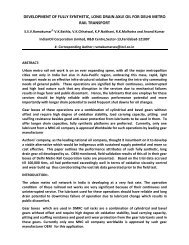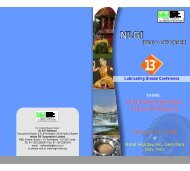Molybdenum Disulfide in Greases - A Review - (NLGI) - India Chapter
Molybdenum Disulfide in Greases - A Review - (NLGI) - India Chapter
Molybdenum Disulfide in Greases - A Review - (NLGI) - India Chapter
Create successful ePaper yourself
Turn your PDF publications into a flip-book with our unique Google optimized e-Paper software.
MOLYBDENUM DISULFIDE IN LUBRICANT APPLICATIONS – A REVIEWYakov Epshteyn and Thomas J. RisdonClimax <strong>Molybdenum</strong>A Freeport-McMoRan CompanyPhoenix, Arizona, USAPresented at the 12 Lubricat<strong>in</strong>g Grease Conference<strong>NLGI</strong>-<strong>India</strong> <strong>Chapter</strong>28-30 January 2010Hotel Cedade de GoaGoa, <strong>India</strong>
MOLYBDENUM DISULFIDE IN LUBRICANT APPLICATIONS – A REVIEWYakov Epshteyn* and Thomas J. Risdon**Climax <strong>Molybdenum</strong>A Freeport-McMoRan CompanyAbstract<strong>Molybdenum</strong> disulfide is one of the best known solid lubricants, and although it orig<strong>in</strong>allyga<strong>in</strong>ed popularity <strong>in</strong> aerospace and military applications, it is now commonly found <strong>in</strong> avariety of lubrication applications. It is widely used <strong>in</strong> greases and specialized grease-likeproducts known as pastes, <strong>in</strong> fluid lubricants such as automotive and <strong>in</strong>dustrial gear oils, <strong>in</strong>solid film lubricants <strong>in</strong>clud<strong>in</strong>g but not limited to burnished (rubbed-on) films, sputteredcoat<strong>in</strong>gs, res<strong>in</strong> bonded and imp<strong>in</strong>gement coat<strong>in</strong>gs.This paper reviews the properties of MoS 2 <strong>in</strong>clud<strong>in</strong>g physical and chemical properties,electrical properties, effects of temperature and oxidation as well as application areas such asgreases, fluid lubricants, and solid film (dry) lubricants where molybdenum disulfide iswidely implemented.* Chief Eng<strong>in</strong>eer, Lubrication-Climax <strong>Molybdenum</strong>** Consult<strong>in</strong>g Eng<strong>in</strong>eer, Solid Lubricant Solutions, Dexter, MI2
Properties of molybdenum disulfide<strong>Molybdenum</strong> disulfide is a dark gray to black powder (the color depend<strong>in</strong>g on its particlesize). The most important, basic physical properties are listed <strong>in</strong> the table below and some ofthe additional physical properties given <strong>in</strong> Reference 1.• Density 4.9• Color blue gray to black• Molecular weight 160.08• Crystal form Hexagonal, rhombohedral• Electrical Conductivity Low but variable• Vacuum Lubrication Excellent• Radiation Stability Good• Magnetic properties Diamagnetic• Dissociation temp. 1370 o C (non-oxidiz<strong>in</strong>g environment)• Melt<strong>in</strong>g Po<strong>in</strong>t 1700 o C (under pressure)• Sublimation temp. 1050 o C <strong>in</strong> high vacuum<strong>Molybdenum</strong> disulfide exists <strong>in</strong> two crystall<strong>in</strong>e forms, hexagonal and rhombohedral. Thehexagonal form is by far the most common and be<strong>in</strong>g the only type found <strong>in</strong> commercial ores.Also, the hexagonal form has been found <strong>in</strong> synthetic MoS 2 . The rhombohedral was firstidentified <strong>in</strong> a synthetic material 2 and subsequently found <strong>in</strong> several natural sources 3 .The hexagonal form is characterized by MoS 2layers <strong>in</strong> which the Mo atoms have trigonalprismatic coord<strong>in</strong>ation of six sulfur atoms, with two molecules per unit cell. The crystalstructure consists of "sandwiches" <strong>in</strong> which one planar hexagonal layer of molybdenum atomsis <strong>in</strong>terspersed between two layers of sulfur atoms.<strong>Molybdenum</strong> disulfide is classified as a transition metal dichalcogenide (TMD) which<strong>in</strong>cludes the disulfides, diselenides and ditellurides of Ti, Zr, Hf, V, Nb, Ta, Cr, Mo, and W.These compounds exist <strong>in</strong> various crystall<strong>in</strong>e forms but only the Mo and W compounds formthe MoS 2hexagonal type crystal structure 4 .Thus the excellent lubricant properties of MoS 2are attributable to the large spac<strong>in</strong>g (andweak Van der Waals bond<strong>in</strong>g) between S-Mo-S sandwich layers. Differences <strong>in</strong> lubricat<strong>in</strong>gbehavior among the TMD compounds are attributable to the distribution of electrons on theconstituent atoms. In MoS 2, there are six non-bond<strong>in</strong>g electrons which can completely fill aband which physically conf<strong>in</strong>es the electrons with<strong>in</strong> the crystal structure 5 . This creates a netpositive charge on the surface of the S-Mo-S sandwich layers which promotes easy shear3
• products of MoS 2 oxidation can cause an <strong>in</strong>crease of friction• oxidation of MoS 2 can cause problems with gell<strong>in</strong>g capabilities <strong>in</strong> some greases• oxidation of MoS 2 can lower maximum temperature for usage of MoS 2• oxidation process determ<strong>in</strong>es shelf life of MoS 2At the same time it would be <strong>in</strong>correct to over estimate the contribution of molybdenumdisulfide oxidation to its lubrication capabilities because the typical, stable product ofmolybdenum disulfide oxidation is MoO 3 which is not abrasive 8 . Therefore, even afterconsiderable degree of oxidation, molybdenum disulfide can still deliver an acceptable levelof lubrication performance.The electrical properties behaviors of MoS 2 are of significant practical importanceparticularly for implementation <strong>in</strong> electrical brushes and spacecraft. Most conductivitymeasurements have been conducted on either large s<strong>in</strong>gle crystals or compacts of MoS 2 .Accord<strong>in</strong>g to Lansdown’s observation 8 there is no clear agreement about electricalconductivity of MoS 2. However, the general view is that molybdenum disulfide could beclassified as a “p” type semiconductor 9 .There is a strong correlation between MoS 2conductivity and temperature. Despite the factthat absolute values of resistivity or conductivity could be different it is well established thatwith <strong>in</strong>creas<strong>in</strong>g temperature MoS 2demonstrates a gradual decrease <strong>in</strong> resistivity and <strong>in</strong>crease<strong>in</strong> conductivity.The conductivity also is a function of the direction of the current flow <strong>in</strong> relation to thecrystal structure especially at the higher temperature. Electrical conductivity at roomtemperature for several s<strong>in</strong>gle crystals ranged from 0.16 to 5.12 Ω -1 cm -1 along the cleavageplane and from 1.02 x 10 -4 to 5.89 x 10 -4 Ω -1 cm -1 parallel to it 10 . At the same time it wasdemonstrated 11 that at 19 o C the resistance is the same regardless of the direction of thecurrent flow <strong>in</strong> relation to the crystal structure.There are also varieties of parameters that potentially can correlate with MoS 2resistivity.However parameters such as the applied current potential, pressure and light appears to bemuch less significant compared to temperature and level of impurities (contam<strong>in</strong>ants) ofMoS 2.5
<strong>Greases</strong><strong>Greases</strong> conta<strong>in</strong><strong>in</strong>g molybdenum disulfide are implemented <strong>in</strong> a wide variety of applications<strong>in</strong> nearly all markets where greases are used and <strong>in</strong> virtually all types of grease thickenersystems, <strong>in</strong>clud<strong>in</strong>g bentonite clay, lithium, lithium 12-hydroxysterate, lithium complex,alum<strong>in</strong>um complex and polyurea. It has also been cited as a useful additive <strong>in</strong> titaniumcomplex greases, that <strong>in</strong> themselves have <strong>in</strong>herently high load carry<strong>in</strong>g capability, to obta<strong>in</strong>even better performance 12 .In general greases conta<strong>in</strong> 1 to 2% of MoS 2 with critical parameters be<strong>in</strong>g surfaceroughness, load and speed. For the relatively rough metal surface the large MoS 2 particlessize is desirable because large particles fill the deep valleys and facilitate the establishment ofa smoother f<strong>in</strong>ish. For a smoother f<strong>in</strong>ish mid and small particles will provide better loadcar<strong>in</strong>gability at a given MoS 2 concentration. At the same time very small particles canpotentially generate some corrosion issues due to the higher acid numbers. In general, midsize particles with median particle size ~ 6 µm (correspond<strong>in</strong>g to Climax Technical F<strong>in</strong>eGrade) is the most commonly used MoS 2 particle size <strong>in</strong> greases.<strong>Molybdenum</strong> disulfide grease markets <strong>in</strong>clude transportation, construction (on and offroad), m<strong>in</strong><strong>in</strong>g, agricultural and military/aerospace.In the transportation sector, Ford Motor Company developed a grease (Spec M1C75B)conta<strong>in</strong><strong>in</strong>g MoS 2 and high density polyethylene that has been used s<strong>in</strong>ce 1961 <strong>in</strong> steer<strong>in</strong>gl<strong>in</strong>kages, ball jo<strong>in</strong>ts and wheel bear<strong>in</strong>gs. MoS 2 grease is also used <strong>in</strong> the constant velocityjo<strong>in</strong>ts (CVJ) used <strong>in</strong> front-wheel drive cars and some rear drive cars that have CVJ’s as part ofthe drivetra<strong>in</strong>. In CVJ’s, as well as many other applications, the grease as a whole passes <strong>in</strong>tothe contact zone rather than only the oil component of the grease. Fish 13 has detailed thecomplex and demand<strong>in</strong>g role that greases play <strong>in</strong> the lubrication of CVJ’s, many of whichconta<strong>in</strong> MoS 2 . Also <strong>in</strong> the transportation sector, railroad curve-rail greases, either petroleumor soybean oil based, conta<strong>in</strong><strong>in</strong>g MoS 2 and/or other solid lubricants are be<strong>in</strong>g used to reducewheel/rail wear and fuel consumption 14 .6
In construction, m<strong>in</strong><strong>in</strong>g and agricultural markets, greases conta<strong>in</strong><strong>in</strong>g MoS 2 are used asOEM lubricants by most equipment manufacturers, and also supplied to the aftermarket.Applications <strong>in</strong>clude k<strong>in</strong>gp<strong>in</strong>s, ball jo<strong>in</strong>ts, pivot p<strong>in</strong>s and spherical frame pivot bear<strong>in</strong>gs 15 .These greases are used to enhance the runn<strong>in</strong>g-<strong>in</strong> process of new components as well asprotect<strong>in</strong>g load-bear<strong>in</strong>g surfaces operat<strong>in</strong>g under arduous conditions.Grease-like products conta<strong>in</strong><strong>in</strong>g a high percentage (50-70%) of MoS 2 and other solidlubricants are referred to as pastes. These products are typically used as problem solvers forapplications such as automotive eng<strong>in</strong>e re-builds, new gear sets, and as anti-seize lubricantsfor threaded connections. A paste conta<strong>in</strong><strong>in</strong>g 50% MoS 2 <strong>in</strong> a silicone oil is used as a back<strong>in</strong>gplate lubricant <strong>in</strong> vehicles with disc brakes.Military applications for MoS 2 -conta<strong>in</strong><strong>in</strong>g greases parallel many of those found <strong>in</strong> nonmilitarymarkets. For example Mil G-23549 is a general purpose clay thickened greaseconta<strong>in</strong><strong>in</strong>g 5% MoS 2 that is used to lubricate Navy catapults on aircraft carriers and also <strong>in</strong>military automotive vehicles. Mil G-21164 is a lithium complex grease conta<strong>in</strong><strong>in</strong>g 5% MoS 2<strong>in</strong> a synthetic base oil recommended for heavily loaded slid<strong>in</strong>g surfaces.Fluid Lubricants<strong>Molybdenum</strong> disulfide can be effectively used to reduce friction and wear <strong>in</strong> fluidlubricants (oils) under boundary conditions, to provide <strong>in</strong>creased load-carry<strong>in</strong>g capacity and<strong>in</strong> the event of oil loss may prevent/delay catastrophic seizure. Despite the fact that <strong>in</strong>dispersions the concentration of MoS 2 could be between 0.1 and 60%, <strong>in</strong> most of cases ofMoS 2 dispersions <strong>in</strong> oil, the concentration is less than 3% 8 .If fluid lubricants are highly viscous or can be stirred frequently they may be able toutilize small 1-2 µm MoS 2 particles (Super F<strong>in</strong>e Grade accord<strong>in</strong>g to Climax classification).Gears that have a significant amount of slid<strong>in</strong>g contact such as worm gears, helical gears andhypoid gears are responsive to the presence of MoS 2 <strong>in</strong> the gear lubricant. A laboratory studyof worm gear lubricants <strong>in</strong> an actual worm gear speed reducer, it was shown that <strong>in</strong> both am<strong>in</strong>eral oil based AGMA #8 compounded oil and <strong>in</strong> a PAO based oil, the addition of a 1%colloidal dispersion of MoS 2 resulted <strong>in</strong> up to 5% improved efficiency and lower bulk oiltemperatures 16 .7
In automotive hypoid axle tests, conducted under laboratory conditions, a 1% dispersionof MoS 2 <strong>in</strong> an 80W gear oil, a 1.5% ga<strong>in</strong> <strong>in</strong> axle efficiency was achieved 17 .In another series of tests with a tractor-trailer test vehicle hav<strong>in</strong>g a 52,000 kg gross vehicleweight, a tow<strong>in</strong>g dynamometer simulated a loaded vehicle climb<strong>in</strong>g a 10% grade. The fully<strong>in</strong>strumented test vehicle recorded lubricant temperature <strong>in</strong> a 90 m<strong>in</strong>ute test. The SAE 90multipurpose lubricant with 1% MoS 2 added gave a consistent 8 C lower operat<strong>in</strong>gtemperature than the same oil without MoS 18 2 .Solid Film LubricationSolid film lubricants are those that can provide lubrication to slid<strong>in</strong>g surfaces without thepresence of a fluid film (i.e., a grease or oil film). Solid film coat<strong>in</strong>gs/lubricants are materialswith <strong>in</strong>herent lubricat<strong>in</strong>g properties, and which are firmly bonded to the surface of a substrateby some method.Burnished FilmsOne of the properties of MoS 2 is that it can be physically rubbed on most metal substratesestablish<strong>in</strong>g a lubricant film about 1 to 5µm <strong>in</strong> thickness (for the longest life, the optimumthickness is 3-5 µm). The burnished coat<strong>in</strong>g is frequently used as a lubricant <strong>in</strong> applicationssuch as metal form<strong>in</strong>g dies, threaded parts, sleeve bear<strong>in</strong>gs, liquid oxygen valves andelectrical contacts <strong>in</strong> relays and switches. In these applications, the MoS 2 burnished coat<strong>in</strong>gcan be produced from loose powder, dispersions, wire-brush<strong>in</strong>g or even "sandblasted" ontothe metal surface to form a th<strong>in</strong> adherent film. A “sandblast<strong>in</strong>g” (or imp<strong>in</strong>gement) process isused by a major automobile manufacturer to apply a film on eng<strong>in</strong>e pistons. The MoS 2 isdirected onto and adheres to the piston surface by entra<strong>in</strong>ment of the powder <strong>in</strong> a highvelocity air stream. The th<strong>in</strong> MoS 2 coat<strong>in</strong>g promotes the runn<strong>in</strong>g <strong>in</strong> process and reducesfriction between the piston skirt and the cyl<strong>in</strong>der wall, thus reduc<strong>in</strong>g fuel consumption.Another example of the use of a burnished MoS 2 film is on O-r<strong>in</strong>gs to reduce frictionbetween the elastomer and the metal surface with which it is <strong>in</strong> contact. The MoS 2 <strong>in</strong> thiscase is applied to the O-r<strong>in</strong>g by barrel tumbl<strong>in</strong>g where hundreds of pieces can be coated at onetime.8
Burnish<strong>in</strong>g can be accomplished by hand rubb<strong>in</strong>g us<strong>in</strong>g a variety of MoS 2 particle sizes(for example, Climax offers MoS 2 <strong>in</strong> three dist<strong>in</strong>ct grades which differ primarily by averageparticle size). However, on a commercial scale, burnish<strong>in</strong>g is usually accomplished withmedium particles size 30 µm (Technical grade accord<strong>in</strong>g to Climax classification) by barreltumbl<strong>in</strong>g us<strong>in</strong>g burnish<strong>in</strong>g aids such as glass beads or crushed walnut shells.Overall, if the burnished films are fully and properly consolidated, they are capable toprovide high load-carry<strong>in</strong>g capacity, very low friction and wear rate. Also, it is one of the besttechniques for lubrication bear<strong>in</strong>gs with very small clearances <strong>in</strong> air.Sputtered Coat<strong>in</strong>gsSputtered coat<strong>in</strong>g of MoS 2 is accomplished by bombard<strong>in</strong>g a target material of compactedMoS 2 with a charged gas (e.g., Argon) which releases atoms <strong>in</strong> the target that coat the nearbysubstrate. The process takes place <strong>in</strong> a magnetron vacuum chamber under low pressure,produc<strong>in</strong>g extremely adherent coat<strong>in</strong>gs of MoS 2 that are typically less than 1 µm thick whichis much th<strong>in</strong>ner, more adherent and shows greater endurance compare to other types of solidlubricant coat<strong>in</strong>gs. Also, MoS 2 sputter<strong>in</strong>g can be performed on a wide variety of substratematerials such as Mo, Fe, Ni, Co, W, Ta, Al, plastics, glass, ceramics and oxidized surfaces(before the sputter<strong>in</strong>g process) of Cu and Ag 8 .Sputtered films of MoS 2 are primarily used <strong>in</strong> vacuum environments such as deep spacewhere very low friction coefficients and low wear are achieved. Good lubricationperformance can also be achieved <strong>in</strong> dry air, but <strong>in</strong> humid air, the tribological properties ofsputtered MoS 2 films deteriorate due to the exposure of crystal edge sites 19 . Anothersignificant disadvantage of sputter<strong>in</strong>g technique is that a sputtered film production requiresspecialized equipment and it is also quite difficult to coat complicated part geometries.Specific applications where sputtered MoS 2 is widely implemented <strong>in</strong>clude the most criticalaerospace applications such as spacecraft and satellite mov<strong>in</strong>g mechanical assemblies, solararray drives, antenna control systems, de-sp<strong>in</strong> mechanisms, as well as similar mechanisms onearth that operate <strong>in</strong> a vacuum or <strong>in</strong>ert environment 19 .Res<strong>in</strong>-Bonded Coat<strong>in</strong>gs9
Res<strong>in</strong>-bonded lubricant coat<strong>in</strong>gs are perhaps the most common product for achiev<strong>in</strong>g adry, self-lubricat<strong>in</strong>g film on metal surfaces. A res<strong>in</strong>-bonded lubricant coat<strong>in</strong>g has beendef<strong>in</strong>ed as a solid lubricant dispersed <strong>in</strong> a cont<strong>in</strong>uous matrix of a b<strong>in</strong>der (<strong>in</strong>organic or organic)and attached to a surface 20 . Many different compositions are commercially available withdifferent b<strong>in</strong>der and additives.A typical formulation is composed of MoS 2, which could be up to 80%, and/or otherlubricat<strong>in</strong>g solids, additives, a b<strong>in</strong>der (organic or <strong>in</strong>organic) and a carrier liquid. Organicres<strong>in</strong>s may <strong>in</strong>clude acrylic, phenolic, epoxy, amide-imide, urethane and polyimide. Newerorganic res<strong>in</strong>s <strong>in</strong>clude polybenzimidazole, and polybenzothiozole. Many newer formulationsconta<strong>in</strong> water-borne res<strong>in</strong>s that are more environmentally friendly (lower VOCs) rather thansolvent based res<strong>in</strong>s. Some products require a heat cur<strong>in</strong>g cycle, while others are ready to useafter dry<strong>in</strong>g at room temperature. Bonded lubricant coat<strong>in</strong>gs can be applied by severalmethods used <strong>in</strong> apply<strong>in</strong>g pa<strong>in</strong>t-like coat<strong>in</strong>gs. These <strong>in</strong>clude conventional spray<strong>in</strong>g,electrostatic spray<strong>in</strong>g, roll-coat<strong>in</strong>g, and dip-coat<strong>in</strong>g/centrifug<strong>in</strong>g, Coat<strong>in</strong>g thickness anduniformity is critical to optimum performance; typical thickness ranges from 8 µm to 18 µm.Some res<strong>in</strong>-bonded coat<strong>in</strong>gs are oil compatible, and are able to provide friction and wearreduction under boundary lubrication conditions. One example is an automotive piston skirtcoat<strong>in</strong>g which improves fuel economy and extends eng<strong>in</strong>e durability 21 . Another applicationfor bonded lubricant coat<strong>in</strong>gs is fasteners. In threaded connections, the uniform coefficient offriction provided by the bonded coat<strong>in</strong>g m<strong>in</strong>imizes the possibility of exceed<strong>in</strong>g the yieldstrength of the bolt due to erratic friction dur<strong>in</strong>g tighten<strong>in</strong>g 22 .A variety of MoS 2 particle sizes may be used for bonded coat<strong>in</strong>g applications depend<strong>in</strong>gon the specific formulation. For <strong>in</strong>stance, if the product is <strong>in</strong> aerosol form, the smallestavailable particles may be required to guard aga<strong>in</strong>st spray tip clogg<strong>in</strong>g.SummaryThe molybdenum disulfide used <strong>in</strong> lubricant applications is the purified form of the m<strong>in</strong>eralMolybdenite. The commercial form of lubricant grade of MoS 2 possesses a hexagonal layerlattice crystal structure which gives it low friction and excellent adherence to most metals. Asa solid lubricant, the excellent lubricant properties of MoS 2 are attributable to the large10
spac<strong>in</strong>g (and weak Van der Waals bond<strong>in</strong>g) between S-Mo-S layers and the favorabledistribution of electrons on the constituent atoms. <strong>Molybdenum</strong> disulfide is thermally stable<strong>in</strong> vacuum or <strong>in</strong>ert environments, but <strong>in</strong> air or oxygen it beg<strong>in</strong>s to oxidize to MoO 3 atapproximately 400 o C.MoS 2 is used as a boundary lubrication additive <strong>in</strong> virtually all grease thickener types andconsistencies where high loads, low speeds, high temperatures and stop-start conditions exist.The ma<strong>in</strong> lubricant sectors <strong>in</strong> which MoS 2 greases are used are transportation (automotiveand rail), <strong>in</strong>dustrial, m<strong>in</strong><strong>in</strong>g construction and agricultural and military/aerospace.Pastes are a special form of greases that conta<strong>in</strong> >50% lubricat<strong>in</strong>g solids. These products areused as problem solv<strong>in</strong>g materials, break-<strong>in</strong> aids and anti-seize compounds.In fluid lubricants such as gear oils, MoS 2 dispersions can be effectively used to reducefriction, wear and bulk oil temperature <strong>in</strong> the boundary lubrication conditions found <strong>in</strong> wormgears, helical gears and hypoid gears.Solid film lubricants conta<strong>in</strong><strong>in</strong>g MoS 2 are firmly bonded to slid<strong>in</strong>g surfaces and are able toprovide low friction and low wear without the presence of an oil or a grease. These coat<strong>in</strong>gscan be applied by several techniques <strong>in</strong>clud<strong>in</strong>g burnish<strong>in</strong>g, imp<strong>in</strong>gement, sputter<strong>in</strong>g and res<strong>in</strong>bond<strong>in</strong>g.The most common of these are res<strong>in</strong>-bonded coat<strong>in</strong>gs, which can be applied as th<strong>in</strong>films us<strong>in</strong>g the same processes used for pa<strong>in</strong>t application. Some res<strong>in</strong>-bonded coat<strong>in</strong>gs are oilcompatible, provid<strong>in</strong>g surface protection when the fluid film is too th<strong>in</strong>.References1. Risdon, T.J., "Properties of <strong>Molybdenum</strong> <strong>Disulfide</strong>", Climax <strong>Molybdenum</strong> Company,January 20032. Bell, R.E. and Herfert, R.F. Preparation Characterization of a New Crystall<strong>in</strong>e Form ofMoS2, J.A.C.S.,79, 3351, 19573. Chianelli, R.R., Prestridge, E.B., Pecoraro, T.A. and DeNeufville, J.P. <strong>Molybdenum</strong>disulphide <strong>in</strong> the poorly Crystall<strong>in</strong>e Rag Structure, Science, 203, 1105, 16 March,19794. W. E. Jamison and S. L. Cosgrove, ASLE Trans., 14, (1971), 62-725. W. E. Jamison, ASLE Trans., 15, 4 (1972), 296-3056. H. E. Sl<strong>in</strong>ey, "Proceed<strong>in</strong>gs of USAF Aerospace Fluids and Lubricants Conf., April1963, (350-367). P. M. Ku, ed.7. M. T. Lavik, T. M. Medved and G. D. Moore, ASLE Trans 11, (1968), 44-5511
8. Lansdown A.R. <strong>Molybdenum</strong> Disulphide Lubrication, Tribology Series, 35, Elsevier,p.3809. Magie, P.M., A review of the Properties and Potentials of the New Heavy MetalDerivative Solid Lubricants, Lubric. Eng., 22, 262, 196610. S. R. Guha Thakurta and A. K. Dutta, J. Phys. Chem. Solids, 44, (1983), 407-41611. Mellor, J.F. A Comprehensive Treatise on Inorganic and Theoretical Chemistry,vol.XI, Longmans Green, London, 193112. Kumar, A. Nagar, S.C., Mittal, B.D, et. al., "Titanium Complex Grease for Girth GearApplications", <strong>NLGI</strong> Spokesman, 63, 6(1999)15-1913. Fish, G, <strong>NLGI</strong> Spokesman, 51, 9, (1999), 14-2914. ABIL Advocate, Vol. 7, No. 1, 200215. Nemecek, R. E., Lubrication Eng<strong>in</strong>eer<strong>in</strong>g, 37,5 (1981), 263-26716. Pacholke, P.J. and Marshek, K.M., Lubr. Eng. 43, 8, (1987) 623-62817. Braithwaite, E.R., and Greene, A.B., Wear 46, 2, 197818. Gresty, D.A., Kunz, E.J., and Risdon, T.J., SAE Paper 77083419. Spalv<strong>in</strong>s, T., NASA Technical Memorandum 105292, 199120. Peterson, M. B. and W<strong>in</strong>er, W. O., Wear Control Handbook, ASME, 198021. Selector Guide for Automotive Lubricant Applications, Molykote ® , Dow Corn<strong>in</strong>gCorp., 200522. Bickford, J. H., "Bolt Torque-Gett<strong>in</strong>g it Right", Mach<strong>in</strong>e Design, June 21, (1990), 67-7112


